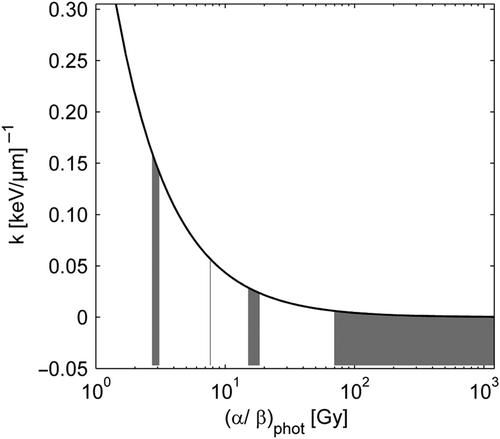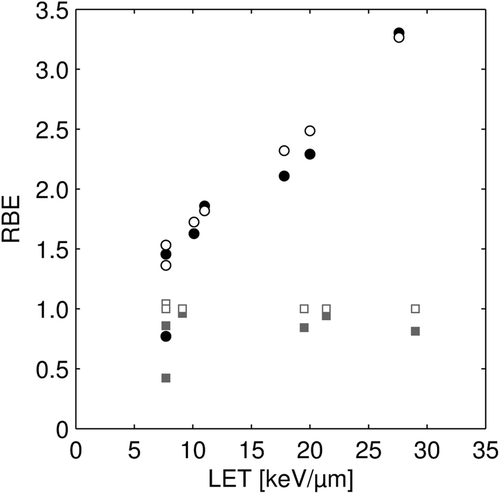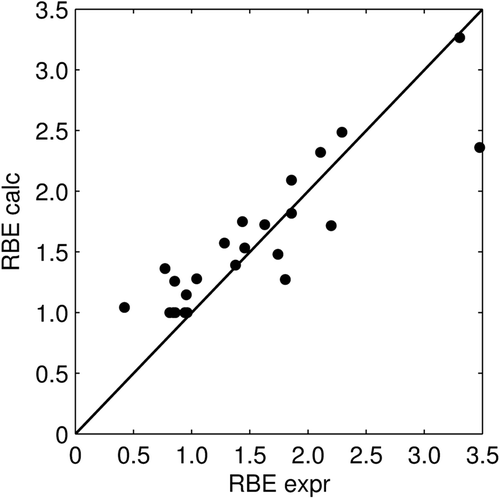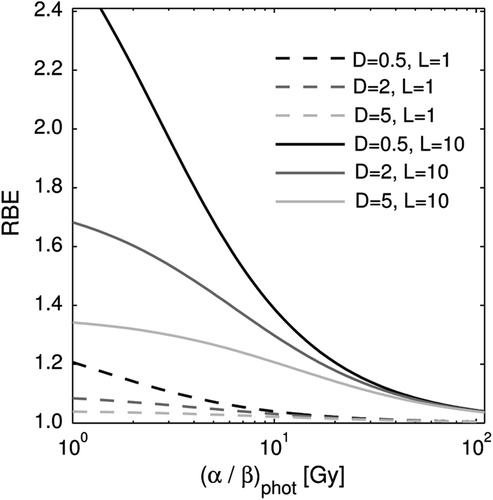Figures & data
Table I. The cell lines used in this study with the published α and β values given in the order of increasing α/β of the reference radiation.
Figure 1. Experimentally obtained α/αphot values as a function of LET. Panel A with (α/β)phot 2.7−3.1: V79-379A cells [12], V79-753B cells [10], and DLD1 cells [17]. Panel B with (α/β)phot 7.7−7.7: SQ20B [13], and C1-1 cells [16]. Panel C with (α/β)phot 15Ȣ18: C3H10T1/2 [11], and SCC25 [13]. Panel D with (α/β)phot ≥ 70: HCT116 [17], M/10 cells and HF19 cells [13]. The error bars show the 95% CI. The dashed lines are obtained with Equation 2 where the highest and lowest (α/β)phot in each panel is used.
![Figure 1. Experimentally obtained α/αphot values as a function of LET. Panel A with (α/β)phot 2.7−3.1: V79-379A cells [12], V79-753B cells [10], and DLD1 cells [17]. Panel B with (α/β)phot 7.7−7.7: SQ20B [13], and C1-1 cells [16]. Panel C with (α/β)phot 15Ȣ18: C3H10T1/2 [11], and SCC25 [13]. Panel D with (α/β)phot ≥ 70: HCT116 [17], M/10 cells and HF19 cells [13]. The error bars show the 95% CI. The dashed lines are obtained with Equation 2 where the highest and lowest (α/β)phot in each panel is used.](/cms/asset/68bf5944-cc64-4f31-9e0c-99401d778286/ionc_a_705892_f0001_b.gif)
Figure 2. k is the slope from the linear relation between α/αphot and LET (see Equation 1) and is here plotted as a function of the α/β ratio of the reference radiation using Equation A6 in Appendix with the parameter q = 0.434. The shaded areas under the curve show the (α/β)phot ranges used in the different panels of Figure 1.

Table II. The resulting slope k of Equation A6 used in .
Figure 3. RBE as a function of LET at 2 Gy photon dose for cell lines with (α/β)phot ratio < 4 (circles) and (α/β)phot ratio ≥ 70 (squares). The experimental data is shown with filled symbols and the calculated data from Equation 3 has open symbols.

Figure 4. Analytically obtained RBE values (see Equation 3) vs. experimental RBE values for all cell lines used in this study. Pearson's correlation coefficient is 0.89. The RBE is obtained at 2 Gy photon dose.

Figure 5. RBE as a function of α/β of the reference radiation using Equation 3. Three doses, 0.5, 2 and 5 Gy, and two LETs, 1 and 10 keV/µm, are compared.

